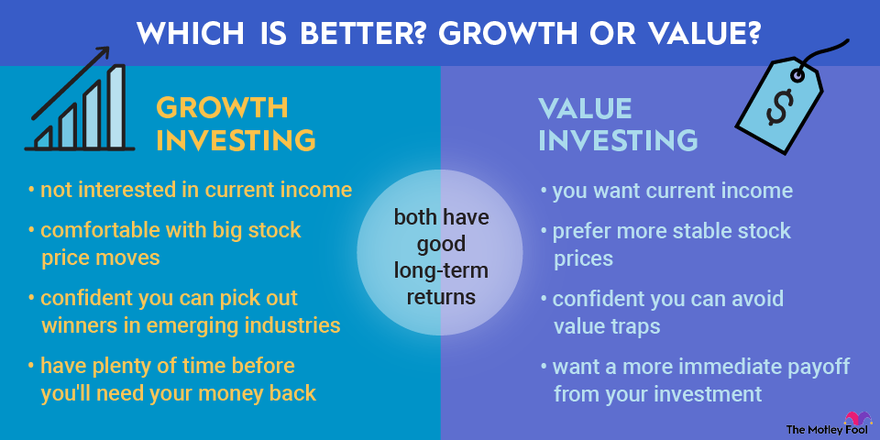Value investing and growth investing are two different investing styles. Usually, value stocks present an opportunity to buy shares below their actual value, and growth stocks exhibit above-average revenue and earnings growth potential.
Wall Street likes to neatly categorize stocks as either growth stocks or value stocks. The truth is a bit more complicated since some stocks have elements of both value and growth. Nevertheless, there are important differences between growth and value stocks, and many investors prefer one style of investing over the other.
Growth stocks
Growth companies prioritize going from small, up-and-coming businesses to leaders in their respective industries as quickly as possible. Early on, these types of companies tend to concentrate on building up their revenue, often at the cost of delaying profitability. After a period of time, growth companies start focusing more on maximizing profits.
As those key financial metrics grow, the perceived value of the company rises in the eyes of growth-minded investors. That can create a positive feedback loop. A rising stock price can boost a company's reputation, helping it win even more business opportunities.
Growth stocks tend to have relatively high valuations as measured by price-to-earnings or price-to-book value ratios. However, they also see faster growth in revenue and income than their peers.
Value stocks
Value stocks are publicly traded companies trading for relatively cheap valuations relative to their earnings and long-term growth potential.
Value stocks don't have flashy growth characteristics. Companies considered value stocks tend to have steady, predictable business models that generate modest gains in revenue and earnings over time. Sometimes you can find value stocks with companies that are in decline. Still, their stock price is so low that it understates the value of their future profit potential.
Which is better: growth or value?
Both growth stocks and value stocks offer lucrative investing opportunities to their shareholders. The best investment style for you depends largely on your personal financial goals and your investing preferences.
Growth stocks are more likely to be appealing if the following apply to you:
- You're not interested in current income from your portfolio. Most growth companies avoid paying significant dividend income to their shareholders. That's because they prefer to use all available cash by reinvesting it directly into their business to generate faster growth.
- You're comfortable with big stock price moves. The price of a growth stock tends to be extremely sensitive to changes in future prospects for a company's business. When things go better than expected, growth stocks can soar in price. When they disappoint, higher-priced growth stocks can fall back to Earth just as quickly.
- You're confident you can pick out winners in emerging industries. You'll often find growth stocks in fast-moving areas of the economy such as the technology sector. It's common for many different growth companies to compete against each other. You'll need to pick as many of the eventual winners in an industry as you can, while avoiding losers.
- You have plenty of time before you'll need your money back. Growth stocks can take a long time to realize their full potential, and they often suffer setbacks along the way. It's critical that you have a long enough time horizon to give the company a chance to grow.
Value stocks may look more attractive if you seek out these characteristics:
- You want current income from your portfolio. Many value stocks pay out substantial amounts of cash as dividends to their shareholders. Because such businesses lack significant growth opportunities, they have to make their stock attractive in other ways. Paying out attractive dividend yields is one way to get investors to look at a stock.
- You prefer more stable stock prices. Value stocks don't tend to see very large movements in either direction. As long as their business conditions remain within predictable ranges, stock price volatility is usually low.
- You're confident you can avoid value traps. In many cases, stocks that look cheap are value traps, or cheap for a good reason. It could be that a company has lost its competitive edge, or it can't keep up with the pace of innovation. You'll have to be able to look past attractive valuations to see when a company's future business prospects are poor.
- You want a more immediate payoff from your investment. Value stocks don't turn things around overnight. However, if a company is successful in getting its business moving in the right direction, its stock price can rise quickly. The best value investors identify and buy shares of those stocks before other investors catch on.
Finally, when it comes to overall long-term performance, there's no clear-cut winner between growth and value stocks. When economic conditions are good, growth stocks on average modestly outperform value stocks. During more difficult economic times, value stocks tend to hold up better. Therefore, which group outperforms depends a lot on the specific time period you're considering.

Tracking growth and value indexes
These trends can be seen in growth and value indexes, which are benchmarks designed to track each group of stocks. The S&P 500 Growth Index (SPYG -1.79%) draws from the roughly 500 stocks in the S&P 500. It selects the stocks that have the best three-year growth in revenue and earnings per share with the strongest upward momentum in price. The S&P 500 Value Index (SPYV -0.54%) selects stocks with the best valuations based on several major stock valuation metrics.
Which is right for you?
There's no reason you can't own both growth stocks and value stocks. Each group has its own attractive qualities. Having diversified exposure to both in your portfolio can give you the best of both worlds.
It's also fine if you identify more with one investing style than the other. Once you settle on your goals for your investments, you'll have a better sense of whether you're a growth investor, a value investor, or a bit of both.







